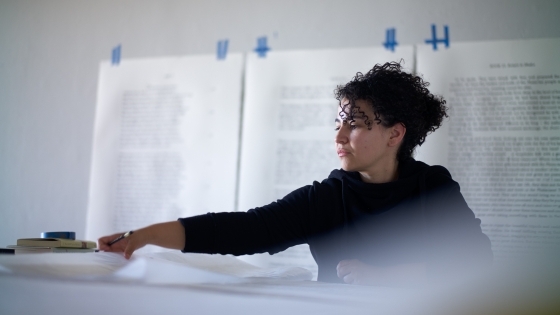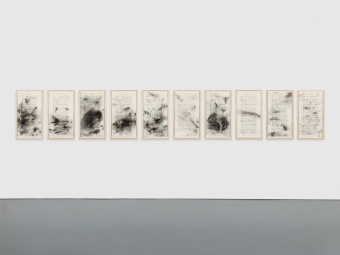Exhibition Connects Haunted Past to Present Through Confederate Anthem

Artist Bethany Collins explores how race and language interact in her multidisciplinary works. Collins’s “Dixie’s Land,” commissioned for Davidson College, opened this week in the Van Every/Smith Galleries. Photography by Chris Edwards and courtesy of McColl Center.
Growing up in Alabama, Bethany Collins never bought the argument that “Dixie” was an innocent song of Southern nostalgia.
She found the song guilty of celebrating a South that battled to keep slavery intact, then later often used violence to prevent free Black people from owning property, voting or holding elected office.
In the theory that it’s better to shine a flashlight on the monster under the bed than to hide under the covers, Collins pored over 100 different versions of the song, its lyrics changed for different times and causes.
“It is a catchy, horrible song,” Collins said. “I remember who sang it, and who didn’t. It still sets my teeth on edge and having to read those lyrics over and over makes the body cringe.”
That research guided “Dixie’s Land (1859-2001)” which opened Aug. 20 at the Van Every/Smith Art Galleries at Davidson College. It’s part of the galleries’ exhibition called “From Pandemic to Protests: Visualizing Social Isolation and Social Injustices Through the Davidson College Art Collection.” The exhibition will run through Oct. 4.
Because of the COVID-19 pandemic, it will be open only to Davidson students, faculty and staff, who must follow social distancing guidelines. Others may view the exhibit online.
The galleries commissioned the art in 2018 as part of Davidson’s reckoning with its own past, and in conjunction with the college’s Commission on Race and Slavery. Like many institutions across the United States, Davidson used enslaved people as farmers, laborers and domestic workers. During Davidson’s first 30 years, three college presidents and many faculty members owned enslaved people. The college also supported Jim Crow era laws that perpetuated white supremacy.
On Wednesday, President Carol Quillen publicly apologized for Davidson’s complicity in slavery and the continuing oppression of Black people. She vowed the college would continue working toward an equitable and antiracist society.
“We have much work to do to understand the pain and injury the college has caused,” Quillen said.

Collins worked with Davidson students to conduct archival research on campus in November 2019. Her visit was funded through the college’s Justice, Equality and Community Grant. Courtesy of the artist and PATRON Gallery, Chicago.
Collins, an artist who draws heavily from linguistics, inspires a longer, harder look at that past. She approached “Dixie” as a representation of the irredeemable parts of American history, and questions what we should do with the irredeemable parts of ourselves, said Lia Newman, the Galleries’ director and curator.
“We can have these challenging conversations when everyone is gathered around artwork in the Galleries,” Newman said. “Bethany’s work is difficult, but it’s accessible. It’s not sensationalizing something horrific. It helps us identify things and really see them for what they are, which is so important as we investigate our actions and our past.”
Dixie’s History
Collins came to Davidson as a Humanities Practitioner in Residence with funding from a Justice, Equality and Community grant the college received. She spent a week at Davidson last November, digging through archives with the help of students to get a sense of the college’s history.
“Dixie” became a recurring theme.
Originally written as Minstrel show tune, “Dixie’s Land,” the song spun a narrative of freed Black people missing their days enslaved on a plantation: “I wish I was in the land of cotton, old times there are not forgotten.”
The song played during the inauguration of the Confederacy’s only president, Jefferson Davis. The Confederacy turned it into an anthem during the Civil War. Union Soldiers played the tune with different lyrics that began, “Away down South in the land of traitors, rattlesnakes and alligators.”
Through archives, Collins learned that a Davidson professor, Paul Barringer, wrote a version, “The War-time Dixie” during World War I.
“Dixie” played at Southern weddings and funerals. Marching bands performed it at college and high school sporting events. That changed during the 1960s, when many schools stopped playing the song because of its glorification of a South that supported white supremacy.
An article from the late 1960s reported the backlash when Davidson banned “Dixie” performances from college events. And yet another reported a campus screening of the movie “Birth of a Nation,” which had originally featured “Dixie” as part of its musical score in the early 20th century.
Collins dug through song books, finding 100 different versions of “Dixie” written between 1859 to 2001. That use of contrafactum, songs where the melody remains constant but the lyrics change, is prevalent in a previous Collins work, “America: A Hymnal”—also in the college’s collection and on view in “From Pandemic to Protests.”
Collins originally planned to create a hymnal from the hundred “Dixie” versions, but instead chose 10 to display separately. They include the Union and Confederate versions, the Barringer lyrics, and one from the Suffrage movement. The last is the 2001 version by René Marie, which leads into Abel Meeropol’s anti-lynching poem, “Strange Fruit.” Billie Holliday and Nina Simone both sang famous, haunting versions of “Strange Fruit.”
Thread Laid Bare
As Collins worked on Dixie, America smoldered.
The pandemic disrupted lives, closed schools and businesses and put many, especially in poor minority communities, on the brink of medical and financial disaster. The pandemic has disproportionately ended more Black and Latino lives than white, further exposing the wide inequities in health care, housing and income.
Then in May, a white Minneapolis police officer killed a Black man, setting off a round of national and international protests, and creating unrest in America’s cities. A horrified world watched the video of George Floyd begging for his life, and then dying as the police officer kneeled on his neck for nine minutes.
It all swirled into Collins’ creation.
She used charcoal to erase some lyrics and highlight others. She changed the melody from jubilant to melancholy. She created charcoal drawings of tear gas deployed by police during the recent protests, placed atop each lyrical version of “Dixie.”
As a nation, we can’t pretend the past doesn’t continue to shape us, Collins said.
“Some of our best work comes from those places, from making something new out of the archive, out of our haunted past,” Collins said. “That’s the challenge of bringing the past to the present.
“Dixie becomes the thread that connects all of our past to now—2020 didn’t come out of nowhere.”
Published
- August 21, 2020
Category
-
Art Gallery